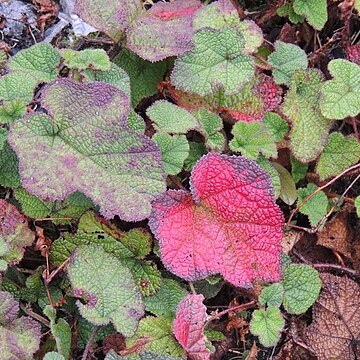Herbs creeping, 15–20 cm tall, main stems creeping, to 2–3 m long, rooting at nodes, with erect sparsely branched or unbranched laterals. Stems with sparse, needle-like prickles or nearly unarmed, with sparse hairs. Leaves simple; petiole 5–10 cm, villous, with needle-like prickles; stipules ovate, rarely obovate, 0.8–1.3 cm × 6–11 mm, margin shallowly coarsely serrate, rarely entire; blade orbicular-ovate or suborbicular, 2.5–6 cm in diam., both surfaces pilose when young, gradually glabrescent, hairy only along veins in age, abaxially with needle-like prickles along veins, base deeply cordate, margin undulate or shallowly 3–5-lobed, irregularly coarsely serrate, apex obtuse or rounded. Inflorescences usually terminal, 1-or 2-flowered; bracts ovate, 6–10 × 5–9 mm, coarsely serrate, very rarely entire. Pedicel 3–5 cm, usually villous, with needle-like prickles. Flowers to 3 cm in diam. Calyx abaxially with soft hairs and straight subulate prickles; tube broadly pelviform, 3.5–5 mm in diam.; sepals leaflike, narrowly ovate to elliptic, 0.8–1.4 cm × 6–11 mm, outer sepals broader, pinnately lobed or incised-serrate, inner sepals narrower, apex or margin coarsely incised-serrate, sometimes entire. Petals white, obovate to elliptic, slightly shorter than sepals, adaxially puberulous, base clawed. Stamens ca. 30–40, shorter than petals; filaments to 6 mm; anthers ca. 1 mm. Pistils ca. 30–50(–70), slightly shorter than stamens; ovary glabrous; styles to 5 mm, glabrous. Aggregate fruit red to dark red, globose, 0.9–1.4 cm in diam., consisting of few drupelets, enclosed in persistent calyx; pyrenes 3–4 mm, rugulose. Fl. May–Jun, fr. Jul–Aug.
More
Main stems creeping, up to 3 m long, rooting on the nodes, with erect, little or not branched laterals in the axils of leaves, all stems sparsely hairy, prickles rather few, small. Leaves reniform, 3-6.5 by 3.5-7 cm, usually shallowly 3-5(-7)-lobecl, base deeply cordate, margin serrate, apex rounded, rather stiff and brittle when dry, nervation pedate with 2-3(-4) pairs of main side-nerves, vena ion reticulate, upper surface with short patent hairs on the nerves and with small prickles between the veins, lower surface with long patent hairs and with needle-shaped, 2.5 mm long prickles on nerves and veins below. Petiole 2.5-9 cm long. Stipules ovate, 9-15 by 6-12 mm, base cordate to rounded, margin finely fimbriate. Flowers solitary, terminal on the laterals, up to 2 cm long stalked, rarely also one flower in the uppermost (reduced) leaf. Hypanthium 3.5-5 mm across, pa-tendy hairy outside and with many needle-like, up to 2.5 mm long prickles. Sepals elliptic to ovate, sometimes cordate, 11-16 by 5-13 mm, in fruit growing to 20 by 15 mm, exposed margins pin-nately lobed with up to 14 lobes, indumentum outside as hypanthium. Petals elliptic to ovate, 10-11 by 5-7 mm, white. Stamens 30-40, glabrous, filaments up to 6 mm, anthers 0.8-1 mm long. Pistils 30-50(-70), ovaries glabrous, on elevated, glabrous torus, styles up to 5 mm long. Fruits orange to red, mesocarp fleshy, only a thin layer when dry, stone 3-4 mm long, endocarp rugulose.
A shrub. It has creeping somewhat woody stems 3 m long. They form roots at the nodes. The fruit are dark red and 14 mm across.
Moist shady banks and forests in the Himalayas, at elevations from 2,100-3,000 metres. Slopes, forests and forest margins in southern China; at elevations from 1,200-3,000 metres.
More
Moist shady banks and forests in the Himalayas, at elevations from 2,100-3,000 metres. Slopes, forests and forest margins in southern China, at elevations of 1,200-3,000 metres.
It is a tropical plant. It grows in moist shady banks. In the Himalayas it grows between 2,200-2,800 m altitude. In Sichuan and Yunnan.
Can be grown by cuttings or seedlings. Seeds needs stratification.

